*NURSING > QUESTIONS & ANSWERS > ATI Funds Assessment Proctor | Funds Proctored Exam Rationales, Complete Latest 2020 Test Bank. (All)
ATI Funds Assessment Proctor | Funds Proctored Exam Rationales, Complete Latest 2020 Test Bank.
Document Content and Description Below
Funds Proctored Exam Rationales 1. A nurse is conducting an admission interview with a client. Which of the following pieces of assessment information should the nurse collect during the introductory ... phase of the interview? A. Clients level of comfort and ability to participate in the interview -The nurse should assess the client’s level of comfort and establish a rapport during the introductory or orientation phase. The nurse should engage in active listening and present a relaxed attitude to place the client at ease and encourage client participation. This will assist the nurse in gaining the necessary data to formulate appropriate nursing diagnoses and outcomes. B. Previous illnesses and surgeries -incorrect: The nurse should assess the client’s health history, including previous illnesses and surgeries, during the working phase of the interview. C. Events surrounding the client’s recent illness -incorrect: The nurse should assess the client’s health history, including events surrounding the recent or current illness, during the working phase of the interview. D. Sociocultural history -incorrect: The nurse should assess the client’s sociocultural history during the working phase of the interview. 2. A nurse is performing an abdominal assessment of a client. Which of the following positions should the nurse tell the client to assume for this examination? A. Lithotomy -incorrect: The lithotomy position is useful for gynecological examinations. B. Lateral -incorrect: The lateral recumbent, or side-lying position, limits access to the abdomen. This position is useful when auscultating the heart to detect murmurs. C. Supine -The nurse should tell the client to assume the supine position to promote relaxation of the abdominal muscles. Having the client bend the knees enhances relaxation of the stomach muscles. D. Sims -incorrect: The Sims’ position limits access to the abdomen. This position is useful for rectal and vaginal examinations. 3. A nurse is caring for a client who is postoperative following an abdominal surgery. Which of the following actions should the nurse perform first after discovering the client’s wound has eviscerated? A. Cover the incision with a moist sterile dressing - The nurse should apply the safety and risk-reduction priority-setting framework, which assigns priority to the factor or situation posing the greatest safety risk to the client. When there are several risks to client safety, the one posing the greatest threat is the highest priority. The nurse should use Maslow’s Hierarchy of Needs, the ABC priority-setting framework, and/or nursing knowledge to identify which risk poses the greatest threat to the client. An open wound increases the risk of peritonitis, and any exposed organ tissue could dry out. Therefore, covering the wound with a moist sterile dressing is the first action the nurse should take to protect the client. B. Have the client lie on his back with his knees flexed -incorrect: The nurse should use this position to reduce pressure on the incision. However, the nurse should take another action first. C. Call the client’s surgeon -incorrect: The nurse should notify the surgeon or direct a colleague to notify the surgeon while tending to the client’s immediate need. However, the nurse should take another action first. D. Reassure the client -incorrect: The nurse should respond to the client’s emotional needs. However, the nurse should take another action first. 4. A nurse is preparing to insert an NG tube for a client who has a bowel obstruction. Which of the following actions should the nurse take first? A. Give the client a glass of water -incorrect: The nurse should provide a glass of water to facilitate swallowing during tube insertion of the NG tube. However, there is another action the nurse should take first. B. Assist the client into a sitting position -incorrect: The nurse should assist the client into a sitting position to insert the NG tube more easily and allow gravity to help facilitate the passage of the tube. However, there is another action the nurse should take first. C. Explain the procedure to the client -The nurse should apply the least invasive priority-setting framework when caring for this client, which assigns priority to nursing interventions that are least invasive to the client, as long as those interventions do not jeopardize client safety. The nurse should take interventions that are not invasive to the client before interventions that are invasive. This reduces the number of organisms introduced into the body, decreasing the number of facility-acquired infections. Informing the client about the procedure reduces fear and assists in gaining the client’s cooperation, which is important for NG tube insertion and is the priority nursing intervention. D. Measure the length of tubing to be inserted -incorrect: The nurse should measure the length of the tubing to be inserted to ensure proper tube placement. However, there is another action the nurse should take first. 5. A nurse is providing discharge teaching to a client who is recovering from lung cancer. The provider instructed the client that he could resume lower-intensity activities of daily living. Which of the following activities should the nurse recommend to the client? A. Sweeping the floor -incorrect: sweeping the floor is moderate-intensity activity B. Shoveling snow -incorrect: Shoveling snow is a high-intensity activity C. Cleaning windows -incorrect: Cleaning windows is a moderate-intensity activity D. Washing dishes -Washing dishes requires a low level of activity and is appropriate for this client. 6. A nurse is caring for a client who is receiving dextrose 5% in water IV at 150 mL/hr and has ingested 4 oz of water and ½ pint of milk. What is the total 8-hr fluid intake in milliliters that the nurse should document for this client? (round to nearest whole number) -1560 7. A nurse is performing a physical examination of a client. The nurse should use percussion to evaluate which of the following parts of the client’s body? A. Heart -incorrect: The nurse uses inspection, palpation, and auscultation to evaluate the heart. B. Lungs -Percussion creates a vibration that helps the examiner determine the density of the underlying tissue. The lungs are hollow organs that can produce sounds such as resonance (a hollow sound over alveoli) or dullness (a dull sound over consolidated areas of the lungs or diaphragm). The nurse also uses auscultation and palpation when evaluating the lungs. C. Thyroid gland -incorrect: The nurse uses inspection and palpation to evaluate the thyroid gland. D. Skin -incorrect: The nurse uses inspection and palpation to evaluate the skin. 8. A nurse is supervising a newly licensed nurse who is administering a controlled substance. Which of the following actions by the newly licensed nurse indicates an understanding of the procedure? A. Placing an unused portion of the medication in a sharps box -incorrect: The nurse should not dispose of an unused portion of a controlled substance in the sharps container because this action does not maintain safe control of the narcotic. B. Asking another nurse to observe the disposal of an unused portion of the medication -The nurse should ask another nurse to witness the disposal of a controlled substance to maintain safe control of the narcotic. C. Counting the inventory of the available narcotic after administering the medication -incorrect: The nurse should count the inventory of the controlled substance before removing a dosage to maintain safe control of the narcotic. D. Ensuring that another nurse signs the control inventory form after disposal of an unused portion of medication -incorrect: Two nurses should sign the control inventory form after the disposal of a portion of a narcotic to maintain safe control. 9. A nurse is caring for a client who has acute renal failure. Which of the following assessments provides the most accurate measure of the client’s fluid status? A. Daily weight -According to the evidence-based priority-setting framework, daily weight provides important information about the client’s fluid status. A gain or loss of 1 kg (2.2 lb) indicates a gain or loss of 1 L of fluid; therefore, weighing the client daily will provide the most accurate fluid status measurement. B. Blood Pressure -incorrect: While blood pressure can indicate a client’s fluid gain or losses, it is not the most accurate method of measuring fluid changes. C. Specific gravity -incorrect: Specific gravity reflects the kidney’s ability to concentrate urine. While specific gravity reflects client’s fluid gains or losses, it is not the most accurate method used to measure fluid changes. D. Intake and Output -incorrect: Intake and output reflect a client’s fluid status. However, this is not the most accurate method to measure fluid changes. 10. A nurse in a long-term care facility is admitting a client who is incontinent and smells strongly of urine. His partner, who has been caring for him at home, is embarrassed and apologizes for the smell. Which of the following responses should the nurse make? A. “A lot of clients who are cared for at home have the same problem” -incorrect: This automatic response implies that caregivers in the home are not able to keep client’s odor-free. It is a judgmental statement that is not therapeutic. B. “Don’t worry about it. He will get a bath, and that will take care of the odor.” -incorrect: Telling the partner not to worry blocks communication by devaluing her feelings and her concern about the odor. C. “It must be difficult to care for someone who is confined to bed.” -This response addresses the feelings of the partner by reflecting her feelings, which facilitates therapeutic communication because it is nonjudgmental and encourages the partner to express her feelings. D. “When was the last time that he had a bath?” -incorrect: This response implies that the odor of urine has developed because she has not bathed her husband for some time, which is judgmental and nontherapeutic. 11. A nurse is caring for a client who has bilateral cats on her hands. Which of the following actions should the nurse take when assisting the client with feeding? A. Sit at the bedside when feeding the client -The nurse should avoid appearing to be in a hurry. Sitting at the bedside provides the client with the nurse’s full attention during the feeding B. Order pureed foods -incorrect: Without any mouth or throat injuries that make chewing or swallowing difficult, the client should be served foods of an appropriate variety of textures. Pureed foods are for clients who cannot chew, have difficulty swallowing, or do not have teeth. C. Make sure feedings are provided at room temperature -incorrect: The nurse should ask the client if the food is the correct temperature D. Offer the client a drink of fluid after every bite -incorrect: If the client is unable to communicate, the nurse should offer the client fluids after every 3 or 4 mouthfuls. However, there is no indication that this client is unable to communicate. Therefore, the client should tell the nurse when she would like a drink. 12. A nurse is administering an IM injection to a 5-month-old infant. Which of the following injection sites should the nurse use? A. Deltoid -incorrect: The nurse can use the deltoid muscle for injecting small volumes of medication for children 18 months of age or older, but its proximity to several nerves and arteries make it a riskier choice. B. Ventrogluteal -incorrect: This is a safe site for IM injections for clients older than 7 months. C. Vastus lateralis -The nurse should use the vastus lateralis site over the anterior thigh for IM injections for infants and children. D. Dorsogluteal -incorrect: This site is unsafe to use because of its proximity to the sciatic nerve and the superior gluteal nerve and artery. 13. A nurse is caring for a client who has major fecal incontinence and reports irritation in the perianal area. Which of the following actions should the nurse take first? A. Apply a fecal collection system -incorrect: The nurse should apply a fecal collection system to divert the feces away from the area of skin irritation; however, there is another action the nurse should take first. B. Apply a barrier cream -incorrect: The nurse should apply a barrier cream to decrease skin breakdown in the perianal area from the feces; however, there is another action the nurse should take first. C. Cleanse and dry the area -incorrect: The nurse should cleanse and dry the perianal area to decrease skin irritation; however, there is another action the nurse should take first. D. Check the client’s perineum -The nurse should apply the nursing process priority-setting framework to plan care and prioritize nursing actions. Each step of the nursing process builds on the previous step, beginning with an assessment or data collection. Before the nurse can formulate a plan of action, implement a nursing intervention, or notify a provider of a change in the client’s status, the nurse must first collect adequate data from the client. Assessing or collecting additional data will provide the nurse with knowledge to make an appropriate decision. The priority nursing action is for the nurse to collect more data by assessing the area of irritation. 14. A nurse is caring for a client who is receiving IV therapy via a peripheral catheter. The nurse should identify that which of the following findings is an indication of infiltration? A. Redness at the infusion site -incorrect: Redness at the infusion site is an indication of phlebitis or infection. B. Edema at the infusion site -Edema due to fluid entering subcutaneous tissue is an indication of infiltration. C. Warmth at the infusion site -incorrect: Warmth at the infusion site is an indication of phlebitis or infection. D. Oozing of blood at the infusion site -incorrect: Oozing of blood at the infusion site is an indication that the IV system is not intact. 15. A nurse is caring for a client who reports not sleeping at night, which interferes with her ability to function during the day. Which of the following interventions should the nurse suggest to this client? A. Avoid beverages that contain caffeine -Caffeine is a stimulant. The nurse should suggest that the client avoid caffeinated beverages. B. Take a sleep medication regularly at bedtime -incorrect: Sleep-promoting medication is a last resort. The nurse should not suggest this type of medication for the client before recommending other nonpharmacological interventions. C. Watch television for 30 minutes in bed to relax prior to falling asleep -incorrect: Clients should associate going to bed with sleep. Therefore, the client should not get into bed until she is sleepy. D. Advise the client to take several naps during the day -incorrect: Napping in the daytime can prevent sound sleep at night 16. A nurse is providing teaching to a client regarding protein intake. Which of the following foods should the nurse include as an example of an incomplete protein? A. Eggs -incorrect: this is a complete protein, contains all of the essential amino acids necessary for the synthesis of protein in the body. B. Soybeans -incorrect: this is a complete protein, contains all of the essential amino acids necessary for the synthesis of protein in the body. C. Lentils -Incomplete proteins are missing 1 or more of the essential amino acids necessary for the synthesis of protein in the body. Examples of incomplete proteins include lentils, vegetables, grains, nuts, and seeds. D. Yogurt -incorrect: this is a complete protein, contains all of the essential amino acids necessary for the synthesis of protein in the body. 17. A nurse is planning to collect a stool specimen for ova and parasites from a client who has diarrhea. Which of the following actions should the nurse take when collecting the specimen? A. Instruct the client to defecate into the toilet bowl -incorrect: The nurse should have the client defecate into a bedpan or a container for stool collection. The toilet water can dilute and contaminate the liquid specimen. B. Transfer the specimen to a sterile container -incorrect: The nurse should place the stool specimen in a clean container using a tongue depressor. C. Refrigerate the collected specimen -incorrect: The nurse should send the collected stool specimen immediately to the laboratory after labeling the specimen properly to prevent contamination with microorganisms and keep the specimen from getting cold. D. Place the stool specimen collection container in a biohazard bag -The nurse should place the specimen collection container in a biohazard bag with the client label on the container and the bag for easy identification. This will also prevent contamination with microorganisms. 18. A nurse is caring for a client who has a tracheostomy and requires suctioning. Which of the following actions should the nurse take? A. Hyper oxygenate the client before suctioning -The nurse should use a manual resuscitation bag to hyper oxygenate the client for several minutes prior to suctioning. B. Insert the catheter during exhalation -incorrect: The nurse should insert the catheter during inhalation C. Apply suction during insertion of the catheter -incorrect: Applying suction while inserting the catheter increases the risk of damage to the tracheal mucosa and removes oxygen from the airways. D. Apply suction for no more than 15 secs -incorrect: The nurse should apply suction for no more than 10 seconds 19. A nurse is caring for a client who was admitted to a long-term care facility for rehabilitation after a total hip arthroplasty. At which of the following times should the nurse begin discharge planning? A. One week prior to the client’s discharge -incorrect: Beginning to plan for the client’s discharge a week prior to the event might not allow sufficient time for planning. The nurse should begin discharge planning at the time of admission. B. Upon the client’s admission to the care facility -The nurse should begin discharge planning at the time that the client is admitted to the facility. C. Once the discharge date is identified -incorrect: Beginning to plan for the client’s discharge once the discharge date is identified might not allow sufficient time for planning. The nurse should begin discharge planning at the time of admission. D. When the client addresses the topic with the nurse -incorrect: Beginning to plan for the client’s discharge once the discharge date is identified might not allow sufficient time for planning. The nurse should begin discharge planning at the time of admission. 20. A nurse is preparing to administer a cleansing enema to a client. Which of the following actions should the nurse plan to take? A. Insert the rectal tube 15.2 cm (6 in) -incorrect: The nurse should insert the rectal tube 7 to 10 cm (3 to 4 in) B. Wear sterile gloves to insert the tubing -incorrect: The nurse should wear clean (nonsterile) gloves to prevent contamination. C. Position the client on his left side -Positioning is an important aspect of administering an enema. Having the client lie on his left side facilitates the flow of the enema solution into the sigmoid and descending colon. D. Hold the solution bag 91 cm (36 inch) above the client’s rectum -incorrect: The nurse should hold the solution bag 30 cm (12 in) above the client’s rectum for a low enema and 45 cm (18 in) for a high enema. If the nurse holds the solution bag too high, the solution might run in too fast, causing discomfort and spasms that make retaining the enema more difficult. 21. A nurse in an emergency department is assessing a client who reports diarrhea and decreased urination for 4 days. Which of the following actions should the nurse take to assess the client’s skin turgor? A. Push on a fingernail bed until it blanches, release it, and observe how long it takes the skin to become pink. -incorrect: This techniqu... [Show More]
Last updated: 1 year ago
Preview 1 out of 152 pages
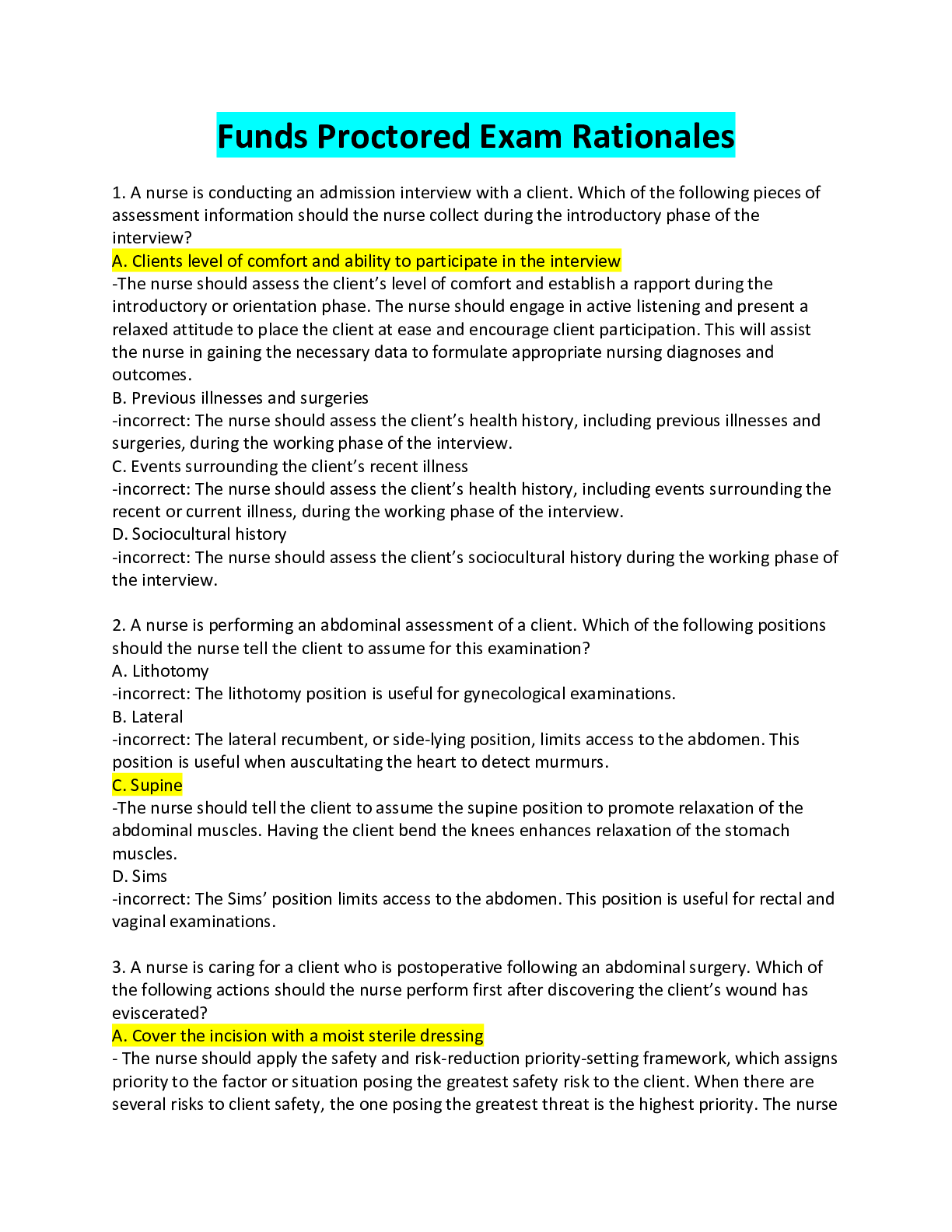
Reviews( 1 )

by candice251111 · 2 years ago
not sure yet
Recommended For You
*NURSING> QUESTIONS & ANSWERS > Fundamentals ATI Proctored Exam Rationales,Test Bank Funds Proctored Exam Rationales (over 400 questions,answers rationales) (All)
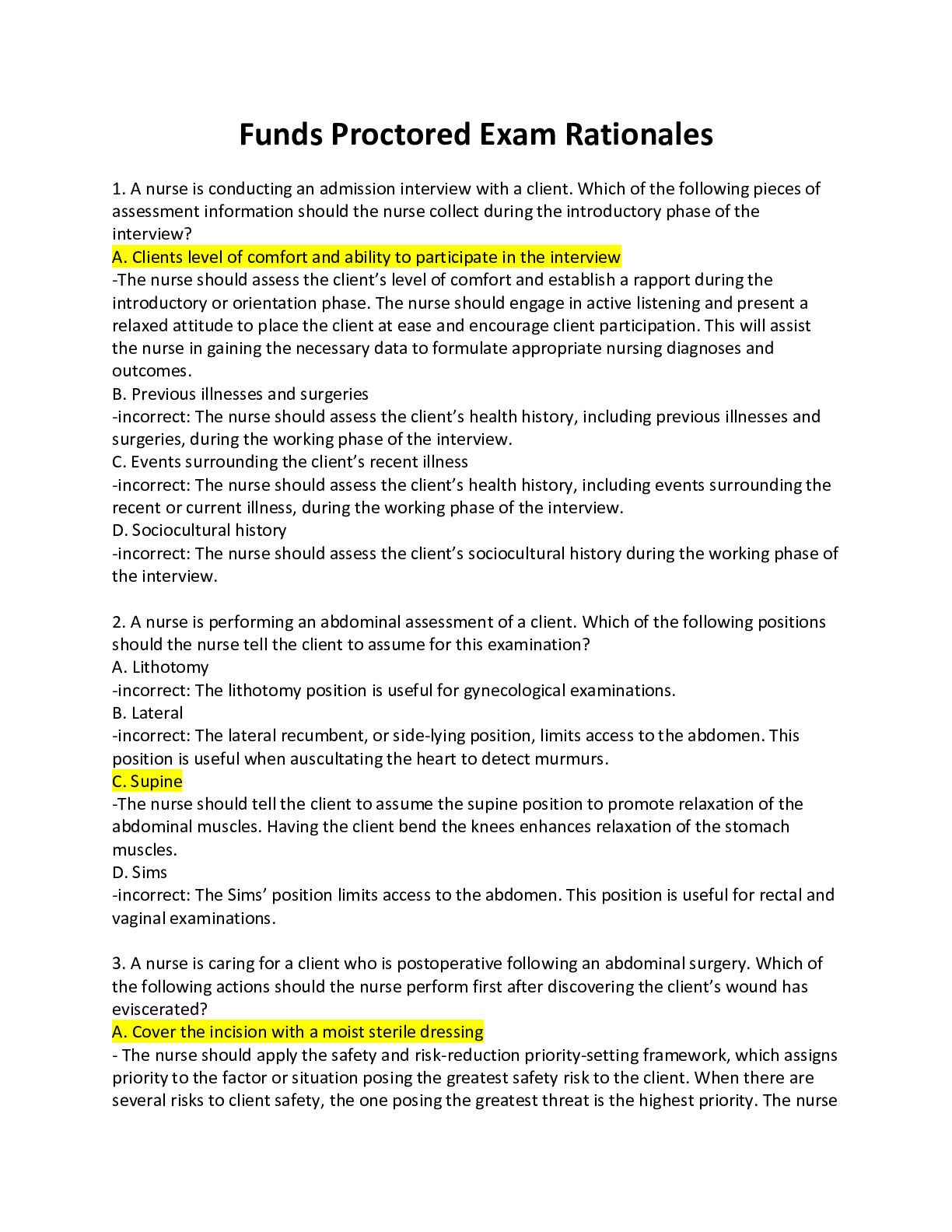
Fundamentals ATI Proctored Exam Rationales,Test Bank Funds Proctored Exam Rationales (over 400 questions,answers rationales)
Funds Proctored Exam Rationales 1. A nurse is conducting an admission interview with a client. Which of the following pieces of assessment information should the nurse collect during the introducto...
By Expert1 , Uploaded: May 30, 2020
$17
Health Care> QUESTIONS & ANSWERS > HESI MENTAL HEALTH RN V1-V3 2020 TEST BANK. (All)
.png)
HESI MENTAL HEALTH RN V1-V3 2020 TEST BANK.
HESI MENTAL HEALTH RN V1-V3 2020 TEST BANK. A client with depression remains in bed most of the day, and declines activities. Which nursing problem has the greatest priority for this client? A...
By Excellentpass , Uploaded: Jul 19, 2022
$8
*NURSING> QUESTIONS & ANSWERS > Fundamentals ATI Proctored Exam Rationales,Test Bank|Latest Spring 2021| Funds Proctored Exam Rationales(over 400 questions,answers rationales) LATEST FOR 2021/2022 (All)
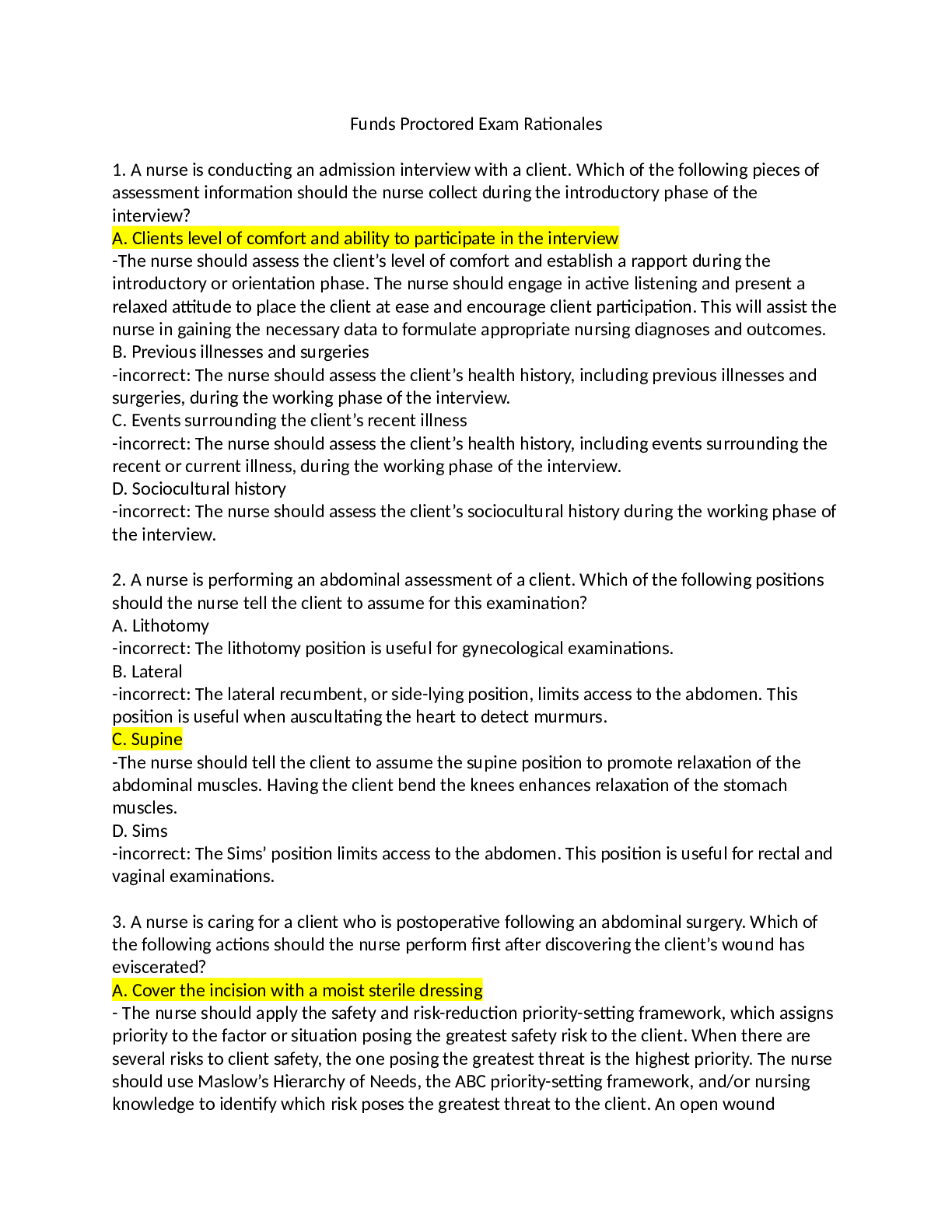
Fundamentals ATI Proctored Exam Rationales,Test Bank|Latest Spring 2021| Funds Proctored Exam Rationales(over 400 questions,answers rationales) LATEST FOR 2021/2022
Funds Proctored Exam Rationales 1. A nurse is conducting an admission interview with a client. Which of the following pieces of assessment information should the nurse collect during the introducto ry...
By A+ Grades , Uploaded: Jul 30, 2021
$33
*NURSING> QUESTIONS & ANSWERS > Fundamentals ATI Proctored Exam Rationales,Test Bank|Latest Spring 2021| Funds Proctored Exam Rationales(over 400 questions,answers rationales) LATEST FOR 2021/2022 (All)

Fundamentals ATI Proctored Exam Rationales,Test Bank|Latest Spring 2021| Funds Proctored Exam Rationales(over 400 questions,answers rationales) LATEST FOR 2021/2022
Funds Proctored Exam Rationales 1. A nurse is conducting an admission interview with a client. Which of the following pieces of assessment information should the nurse collect during the introducto ry...
By Tutor Frankline , Uploaded: Jul 30, 2021
$33
*NURSING> QUESTIONS & ANSWERS > ATI Funds Assessment Proctor | Funds Proctored Exam Rationales, Complete Latest 2021/2022 Test Bank. (All)

ATI Funds Assessment Proctor | Funds Proctored Exam Rationales, Complete Latest 2021/2022 Test Bank.
Funds Proctored Exam Rationales 1. A nurse is conducting an admission interview with a client. Which of the following pieces of assessment information should the nurse collect during the introductory...
By A+ Grades , Uploaded: Jul 26, 2021
$16
*NURSING> QUESTIONS & ANSWERS > ATI Funds Assessment Proctor | Funds Proctored Exam Rationales, Complete Latest 2021/2022 Test Bank. (All)

ATI Funds Assessment Proctor | Funds Proctored Exam Rationales, Complete Latest 2021/2022 Test Bank.
Funds Proctored Exam Rationales 1. A nurse is conducting an admission interview with a client. Which of the following pieces of assessment information should the nurse collect during the introductory...
By Tutor Frankline , Uploaded: Jul 26, 2021
$17
*NURSING> QUESTIONS & ANSWERS > FUNDAMENTALS ATI PROCTORED EXAM RATIONALES, TEST BANK LATEST SPRING 2020/2021 FUNDS PROCTORED EXAM RATIONALES (OVER 400 QUESTIONS, ANSWERS RATIONALES) (All)
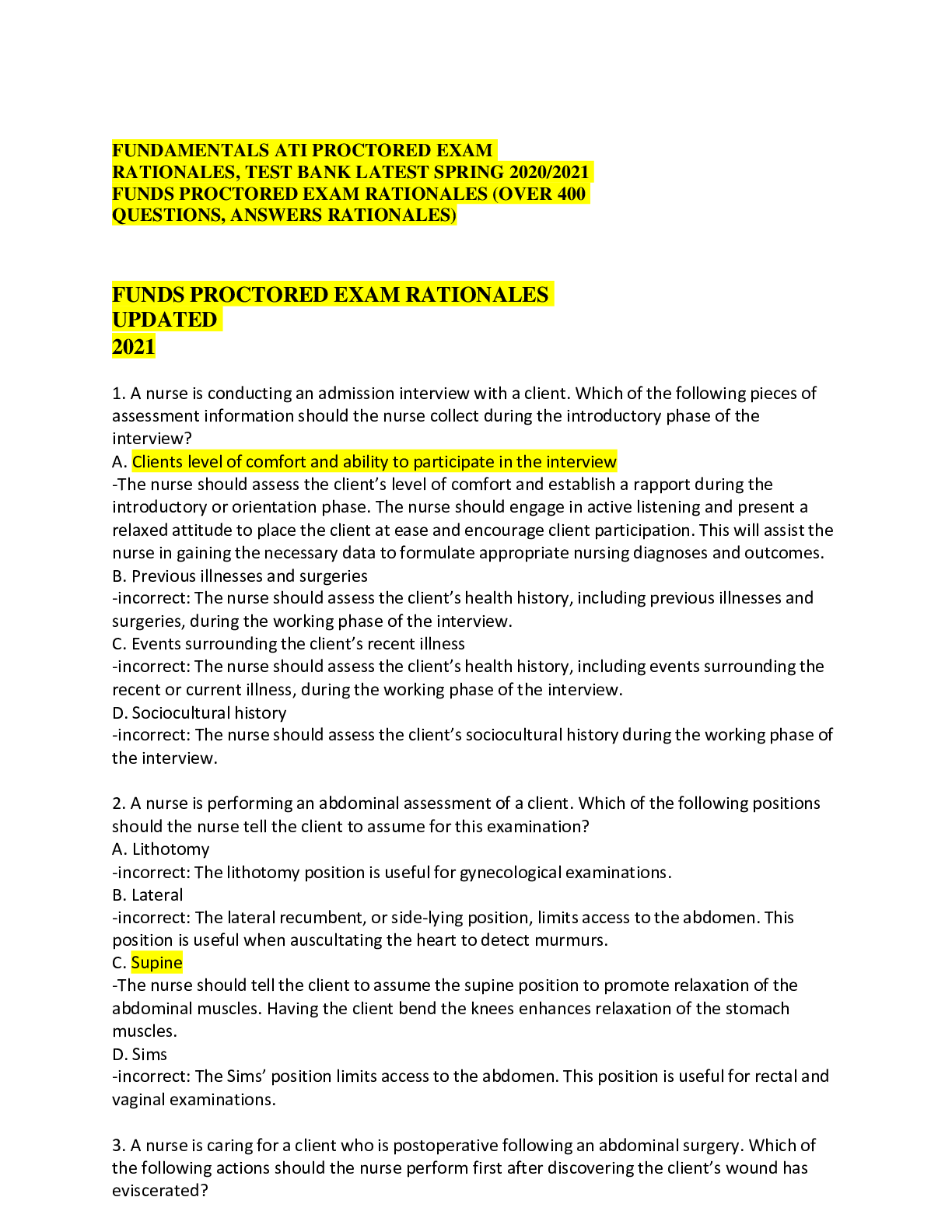
FUNDAMENTALS ATI PROCTORED EXAM RATIONALES, TEST BANK LATEST SPRING 2020/2021 FUNDS PROCTORED EXAM RATIONALES (OVER 400 QUESTIONS, ANSWERS RATIONALES)
1. A nurse is conducting an admission interview with a client. Which of the following pieces of assessment information should the nurse collect during the introductory phase of the interview? A. Clie...
By destinyd , Uploaded: May 24, 2021
$25
*NURSING> QUESTIONS & ANSWERS > ATI Funds Proctored Exam Rationales Test Banks Questions and Answers (latest Update), 100% Correct, Download to Score A (All)
, All Correct, Download to Score A.png)
ATI Funds Proctored Exam Rationales Test Banks Questions and Answers (latest Update), 100% Correct, Download to Score A
ATI Funds Proctored Exam Rationales Test Banks Questions and Answers (latest Update), 100% Correct, Download to Score A
By TopScholar , Uploaded: Apr 23, 2021
$20
*NURSING> QUESTIONS & ANSWERS > Funds Proctored Exam Rationales updated 2022 (All)

Funds Proctored Exam Rationales updated 2022
1. A nurse is conducting an admission interview with a client. Which of the following pieces of assessment information should the nurse collect during the introductory phase of the interview? A. Cl...
By Dennys , Uploaded: Nov 09, 2022
$12
*NURSING> QUESTIONS & ANSWERS > PHIL 347 Week 6 Checkpoint Quiz. Score 100/100 (All)
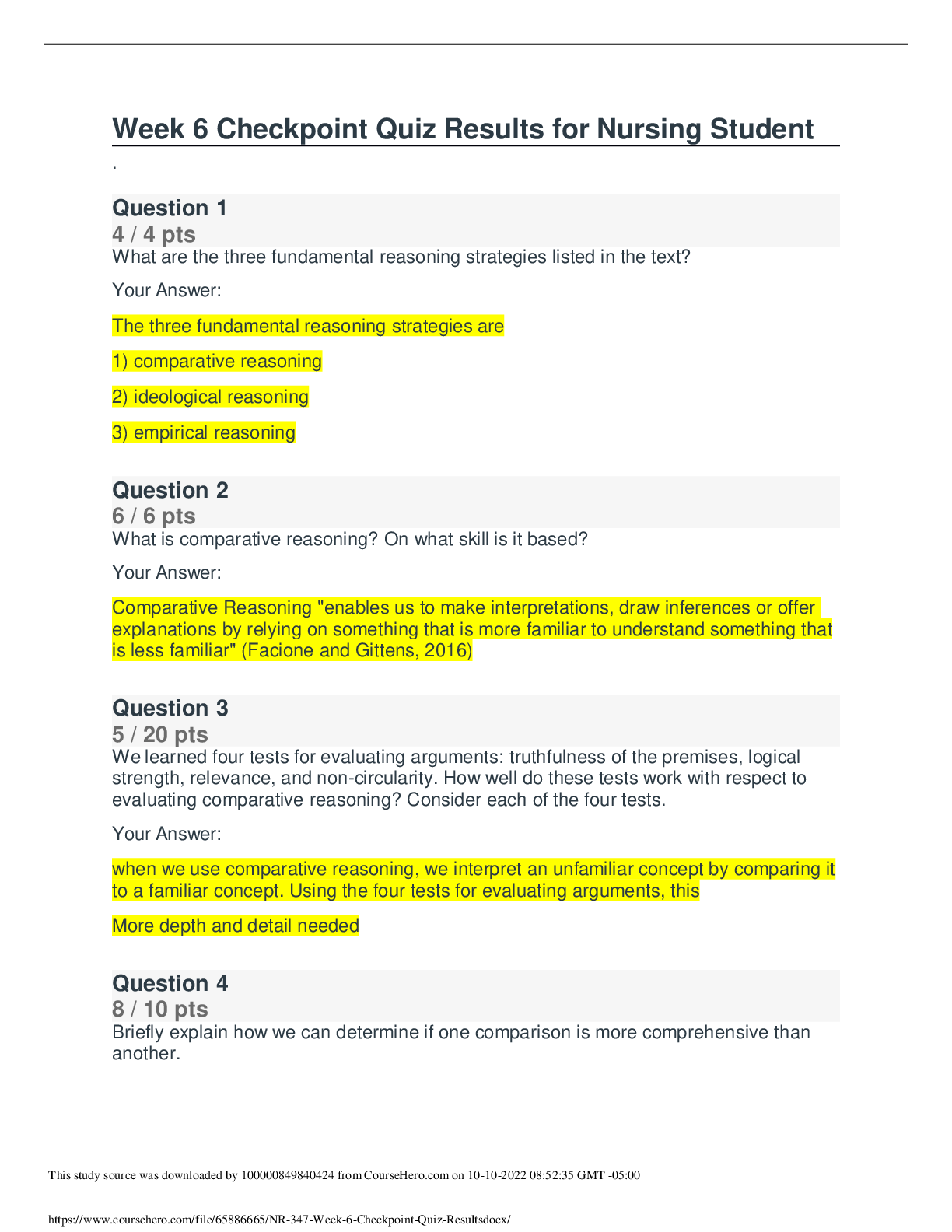
PHIL 347 Week 6 Checkpoint Quiz. Score 100/100
Question: What are the three fundamental reasoning strategies listed in the text? Question: What is comparative reasoning? On what skill is it based? Question: We learned four tests for evaluating...
By Amanda Rosales , Uploaded: Mar 24, 2021
$7
Document information
Connected school, study & course
About the document
Uploaded On
Jul 28, 2020
Number of pages
152
Written in
Additional information
This document has been written for:
Uploaded
Jul 28, 2020
Downloads
2
Views
149





